Page 70 of 450
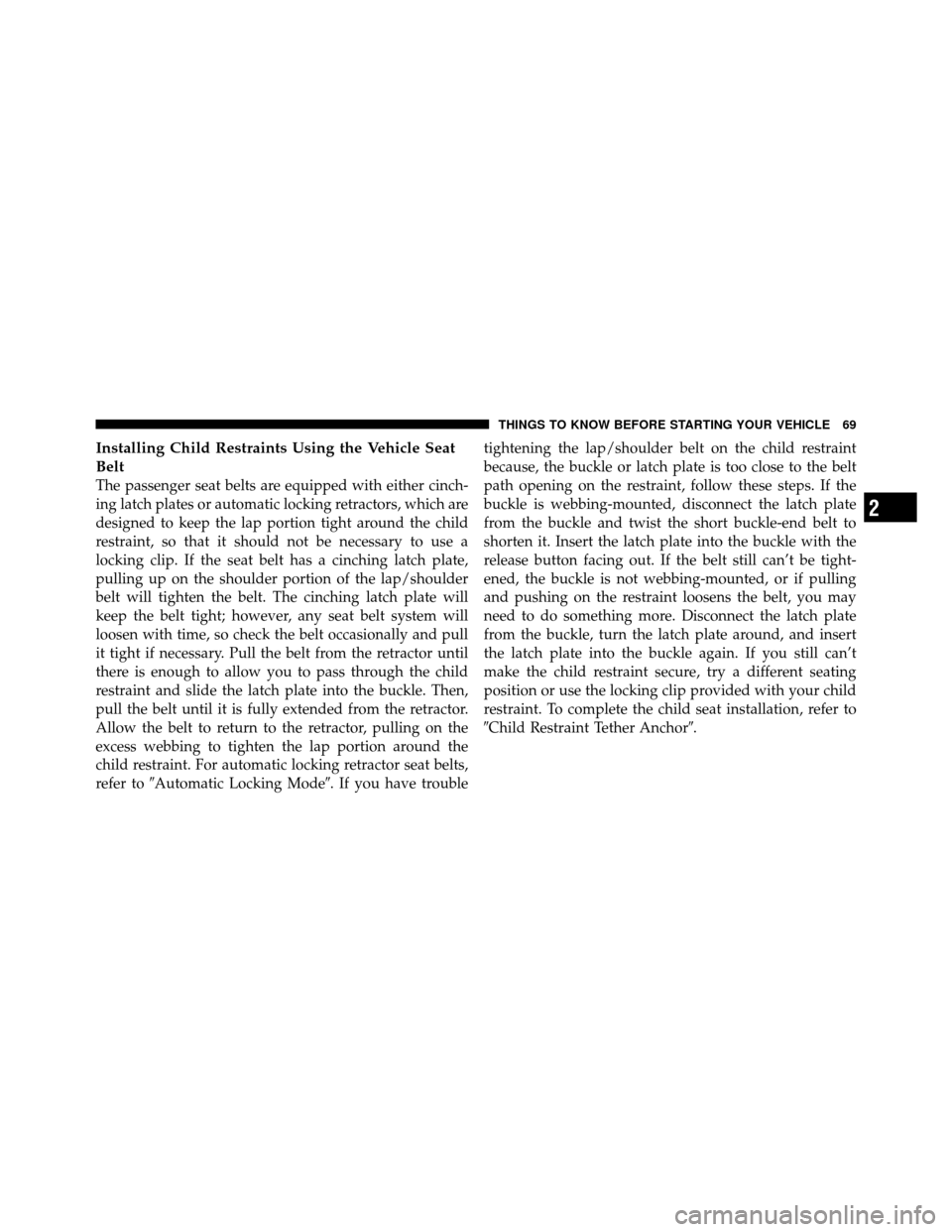
Installing Child Restraints Using the Vehicle Seat
Belt
The passenger seat belts are equipped with either cinch-
ing latch plates or automatic locking retractors, which are
designed to keep the lap portion tight around the child
restraint, so that it should not be necessary to use a
locking clip. If the seat belt has a cinching latch plate,
pulling up on the shoulder portion of the lap/shoulder
belt will tighten the belt. The cinching latch plate will
keep the belt tight; however, any seat belt system will
loosen with time, so check the belt occasionally and pull
it tight if necessary. Pull the belt from the retractor until
there is enough to allow you to pass through the child
restraint and slide the latch plate into the buckle. Then,
pull the belt until it is fully extended from the retractor.
Allow the belt to return to the retractor, pulling on the
excess webbing to tighten the lap portion around the
child restraint. For automatic locking retractor seat belts,
refer to�Automatic Locking Mode�. If you have trouble tightening the lap/shoulder belt on the child restraint
because, the buckle or latch plate is too close to the belt
path opening on the restraint, follow these steps. If the
buckle is webbing-mounted, disconnect the latch plate
from the buckle and twist the short buckle-end belt to
shorten it. Insert the latch plate into the buckle with the
release button facing out. If the belt still can’t be tight-
ened, the buckle is not webbing-mounted, or if pulling
and pushing on the restraint loosens the belt, you may
need to do something more. Disconnect the latch plate
from the buckle, turn the latch plate around, and insert
the latch plate into the buckle again. If you still can’t
make the child restraint secure, try a different seating
position or use the locking clip provided with your child
restraint. To complete the child seat installation, refer to
�Child Restraint Tether Anchor�.
2
THINGS TO KNOW BEFORE STARTING YOUR VEHICLE 69
Page 71 of 450
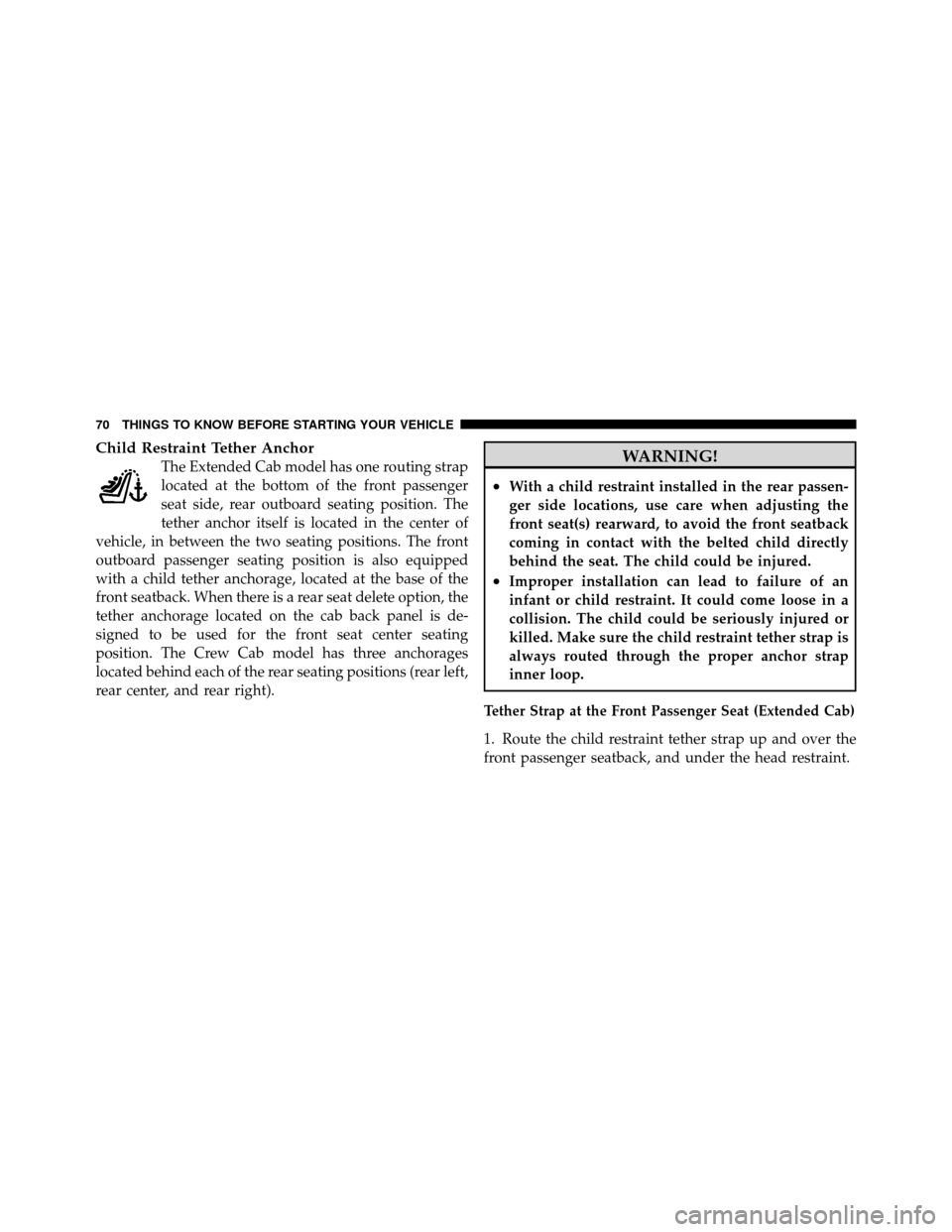
Child Restraint Tether Anchor
The Extended Cab model has one routing strap
located at the bottom of the front passenger
seat side, rear outboard seating position. The
tether anchor itself is located in the center of
vehicle, in between the two seating positions. The front
outboard passenger seating position is also equipped
with a child tether anchorage, located at the base of the
front seatback. When there is a rear seat delete option, the
tether anchorage located on the cab back panel is de-
signed to be used for the front seat center seating
position. The Crew Cab model has three anchorages
located behind each of the rear seating positions (rear left,
rear center, and rear right).WARNING!
•With a child restraint installed in the rear passen-
ger side locations, use care when adjusting the
front seat(s) rearward, to avoid the front seatback
coming in contact with the belted child directly
behind the seat. The child could be injured.
•Improper installation can lead to failure of an
infant or child restraint. It could come loose in a
collision. The child could be seriously injured or
killed. Make sure the child restraint tether strap is
always routed through the proper anchor strap
inner loop.
Tether Strap at the Front Passenger Seat (Extended Cab)
1. Route the child restraint tether strap up and over the
front passenger seatback, and under the head restraint.
70 THINGS TO KNOW BEFORE STARTING YOUR VEHICLE
Page 72 of 450
2. Connect the tether strap to the lower anchor located at
the bottom rear of the seat.
3. Remove the slack in the tether strap so that it is pulled
tight.Tether Straps at the Rear Passenger Seat (Extended Cab)
1. Route the child restraint tether strap through the
routing loop, located directly behind the child restraint.
The routing loops are located behind the flip-down door
on the cab back panel (padded bolster).
Tether Strap
Tether Strap Routing Loop
2
THINGS TO KNOW BEFORE STARTING YOUR VEHICLE 71
Page 73 of 450
2. Route the tether strap across to the center tether
anchorage. The center tether is located behind the slide
door in the center of the vehicle, between the two seating
positions.
3. Remove the slack in the tether strap so that the anchor
strap is pulled tight.Tether Straps at the Rear Passenger Seat (Crew Cab)
1. Route the child restraint tether strap under the head
restraint for the outboard seating positions, and then
through the anchor strap outer loop (webbing material
loop), located directly behind the child restraint.
2. Route the tether strap across to the nearest installed
anchor strap, and attach the tether strap hook to the
anchor strap inner metal ring.
3. Remove the slack in the tether strap so that both
anchor straps are pulled tight.
NOTE:
Two anchors must be used for any of the three
seating positions.
Tether Strap Routing
72 THINGS TO KNOW BEFORE STARTING YOUR VEHICLE
Page 74 of 450
WARNING!
An incorrectly anchored tether strap could lead to
seat failure and injury to the child. In a collision, the
seat could come loose and allow the child to crash
into the inside of the vehicle or other passengers, or
even be thrown from the vehicle. Use only the anchor
positions directly behind the child restraint to secure
a child restraint top tether strap. See your authorized
dealer for help, if necessary.
Transporting Pets
Airbags deploying in the front seat could harm your pet.
An unrestrained pet will be thrown about and possibly
injured, or injure a passenger during panic braking or in
a collision. Pets should be restrained in the rear seat in
pet harnesses or pet carriers that are secured by seat belts.Multiple Child Restraints
1 — Inner Anchor Strap Rings 4 — Passenger Side Rear ChildSeat
2 — Snap Hook 5 — Center Rear Child Seat
3 — Tether Strap 6 — Drivers Side Rear Child Seat
2
THINGS TO KNOW BEFORE STARTING YOUR VEHICLE 73
Page 250 of 450
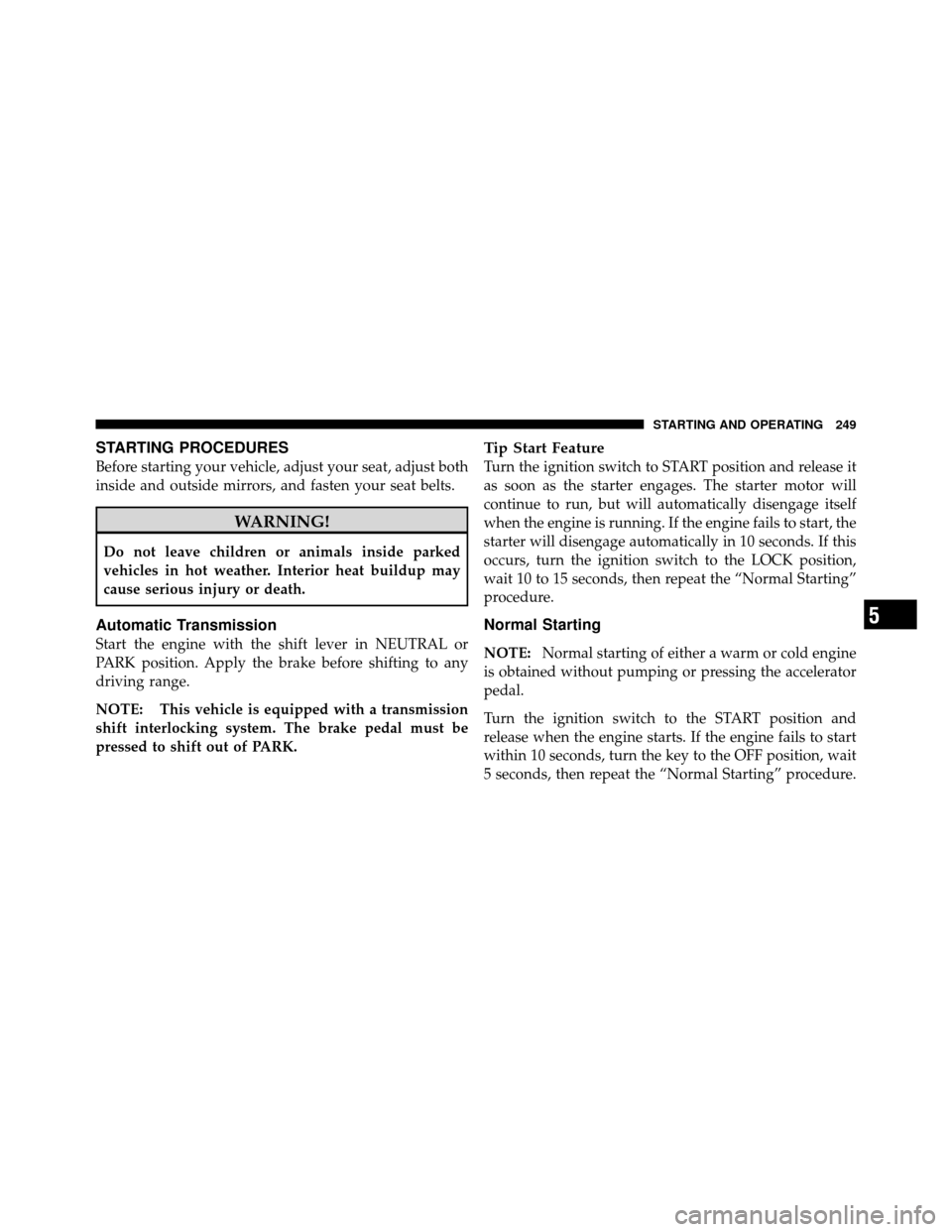
STARTING PROCEDURES
Before starting your vehicle, adjust your seat, adjust both
inside and outside mirrors, and fasten your seat belts.
WARNING!
Do not leave children or animals inside parked
vehicles in hot weather. Interior heat buildup may
cause serious injury or death.
Automatic Transmission
Start the engine with the shift lever in NEUTRAL or
PARK position. Apply the brake before shifting to any
driving range.
NOTE: This vehicle is equipped with a transmission
shift interlocking system. The brake pedal must be
pressed to shift out of PARK.
Tip Start Feature
Turn the ignition switch to START position and release it
as soon as the starter engages. The starter motor will
continue to run, but will automatically disengage itself
when the engine is running. If the engine fails to start, the
starter will disengage automatically in 10 seconds. If this
occurs, turn the ignition switch to the LOCK position,
wait 10 to 15 seconds, then repeat the “Normal Starting”
procedure.
Normal Starting
NOTE:Normal starting of either a warm or cold engine
is obtained without pumping or pressing the accelerator
pedal.
Turn the ignition switch to the START position and
release when the engine starts. If the engine fails to start
within 10 seconds, turn the key to the OFF position, wait
5 seconds, then repeat the “Normal Starting” procedure.
5
STARTING AND OPERATING 249
Page 435 of 450
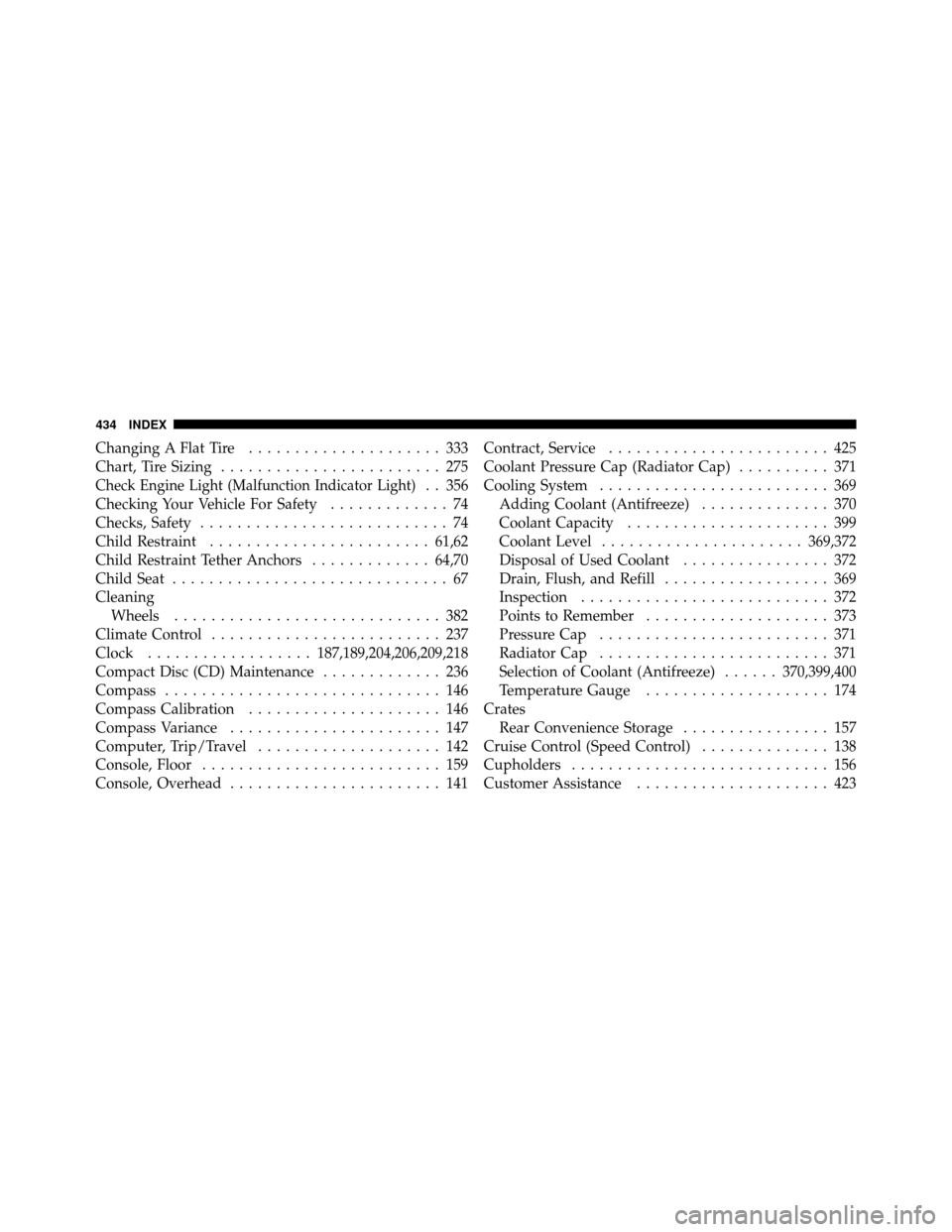
Changing A Flat Tire..................... 333
Chart, Tire Sizing ........................ 275
Check Engine Light (Malfunction Indicator Light). . 356
Checking Your Vehicle For Safety ............. 74
Checks, Safety ........................... 74
Child Restraint ........................ 61,62
Child Restraint Tether Anchors .............64,70
Child Seat .............................. 67
Cleaning Wheels ............................. 382
Climate Control ......................... 237
Clock .................. 187,189,204,206,209,218
Compact Disc (CD) Maintenance ............. 236
Compass .............................. 146
Compass Calibration ..................... 146
Compass Variance ....................... 147
Computer, Trip/Travel .................... 142
Console, Floor .......................... 159
Console, Overhead ....................... 141 Contract, Service
........................ 425
Coolant Pressure Cap (Radiator Cap) .......... 371
Cooling System ......................... 369
Adding Coolant (Antifreeze) .............. 370
Coolant Capacity ...................... 399
Coolant Level ...................... 369,372
Disposal of Used Coolant ................ 372
Drain, Flush, and Refill .................. 369
Inspection ........................... 372
Points to Remember .................... 373
Pressure Cap ......................... 371
Radiator Cap ......................... 371
Selection of Coolant (Antifreeze) ......370,399,400
Temperature Gauge .................... 174
Crates Rear Convenience Storage ................ 157
Cruise Control (Speed Control) .............. 138
Cupholders ............................ 156
Customer Assistance ..................... 423
434 INDEX
Page 441 of 450
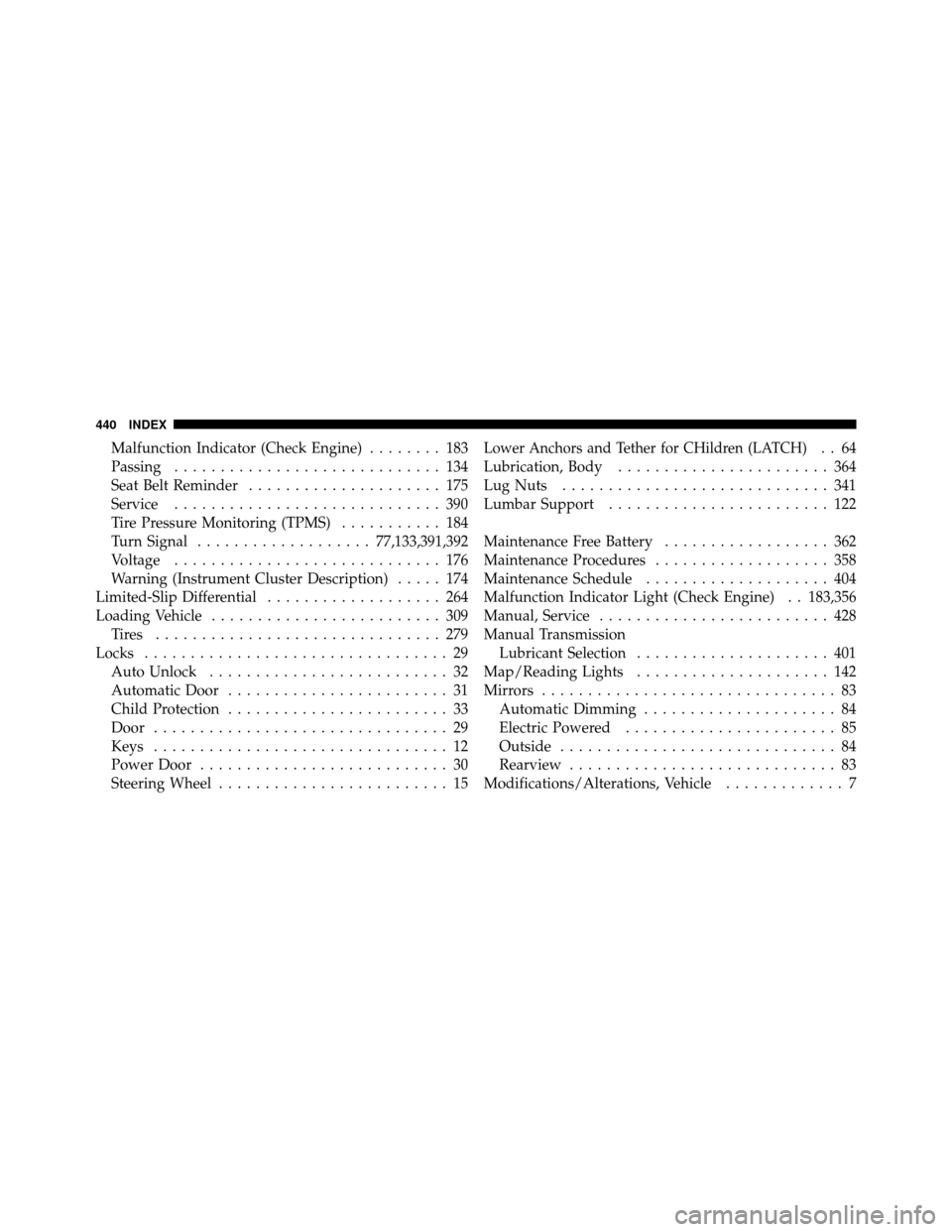
Malfunction Indicator (Check Engine)........ 183
Passing ............................. 134
Seat Belt Reminder ..................... 175
Service ............................. 390
Tire Pressure Monitoring (TPMS) ........... 184
Turn Signal ................... 77,133,391,392
Voltage ............................. 176
Warning (Instrument Cluster Description) ..... 174
Limited-Slip Differential ................... 264
Loading Vehicle ......................... 309
Tires ............................... 279
Locks ................................. 29
Auto Unlock .......................... 32
Automatic Door ........................ 31
Child Protection ........................ 33
Door ................................ 29
Keys ................................ 12
Power Door ........................... 30
Steering Wheel ......................... 15Lower Anchors and Tether for CHildren (LATCH).. 64
Lubrication, Body ....................... 364
Lug Nuts ............................. 341
Lumbar Support ........................ 122
Maintenance Free Battery .................. 362
Maintenance Procedures ................... 358
Maintenance Schedule .................... 404
Malfunction Indicator Light (Check Engine) . . 183,356
Manual, Service ......................... 428
Manual Transmission Lubricant Selection ..................... 401
Map/Reading Lights ..................... 142
Mirrors ................................ 83
Automatic Dimming ..................... 84
Electric Powered ....................... 85
Outside .............................. 84
Rearview ............................. 83
Modifications/Alterations, Vehicle ............. 7
440 INDEX